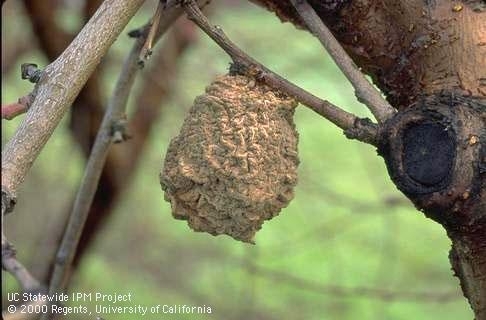- Author: Ed Perry
Many gardeners are interested in knowing how winter temperatures affect garden pests. The hope is that following a cold winter–such as this year–fewer pests will survive to plague the garden. Unfortunately, both insect pests and plant diseases have ways of surviving our harshest winters. However, there are some things that you can do to lessen potential pest problems, mostly by eliminating the places where pests and disease may overwinter.
Although a few pests can migrate great distances, many come from sources within your garden or nearby areas, surviving on weeds, in crop debris, as pupae in soil, or as seeds, spores or eggs. You can also unknowingly bring some pests into your garden on infested transplants or contaminated soil or equipment.
![Codling moth larvae inside a fruit. [Credit: Jack Kelly Clark, UC IPM] Codling moth larvae inside a fruit. [Credit: Jack Kelly Clark, UC IPM]](http://ucanr.edu/blogs/StanislausSprout/blogfiles/57017.jpg)
Good common-sense sanitation practices will help to eliminate overwintering garden pests. In your fruit trees, be sure to remove and destroy old fruit “mummies” hanging in trees and pick up and destroy any fallen nuts. Old fruits and nuts often contain pests such as codling moths. It's also very important to get rid of pruned branches, especially those from your fruit trees, that might be infested with disease or borers. Bark beetles may emerge from infested branches in late winter or early spring, so be sure to dispose of prunings as soon as possible. Don't forget to treat your fruit trees, especially peach and nectarine trees, with fungicide sprays to prevent spring diseases such as peach leaf curl; oil sprays applied now will also help to control overwintering insect and mite pests on deciduous trees.
Also, remove any weeds around your garden well before planting any new crops. Not only do weeds produce seeds that may find their way into your garden, but they are also likely to harbor numerous migrating pests. For instance, cutworms, earwigs, stink bugs, thrips and certain viruses carried by aphids and leafhoppers are all pests associated with weedy areas. If you wait until your garden is planted before destroying these weeds, the pests will move into your crops. Waiting for the weeds to dry out naturally will also encourage pest migrations. Besides, it's easier to control weeds when they're seedlings, rather than waiting until they've matured and set seeds.

Good sanitation also means making sure the planting stock you're using is free of pests. Check transplants or other greenhouse stock for aphids, diseases, nematodes and other pests. Use certified seed or stock if available. Make sure any organic soil amendments you use are free of weed seeds and pathogens, and don't move soil infested with nematodes, Bermudagrass stems, or nutsedge tubers to other parts of your garden. If you're not sure whether the soil is infested with pests, it's best to not take the chance. Also, clean equipment before moving it from infested areas.
Always be sure plant debris, particularly residue from previous vegetable crops, is completely decayed or removed before planting a new crop. A good way to destroy most crop and weed residues around your garden is by composting. Composting destroys most of the pests that may be harbored in the residues.
You can download a free copy of Composting is Good for Your Garden and the Environment to learn more.
Ed Perry is the emeritus Environmental Horticultural Advisor for University of California Cooperative Extension (UCCE) in Stanislaus County.

